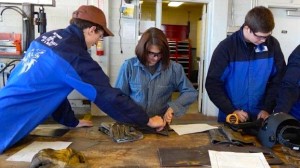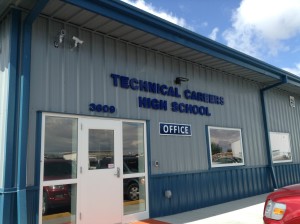Dwight Johnson already knows professional-technical education is the shortest distance between the classroom and a rewarding career for many students. But Johnson and PTE educators across the state are working to streamline the process, provide more opportunities for students and fill more Idaho jobs.

As administrator of the Idaho’s division of Professional-Technical Education, Johnson helps oversee a $62.3 million budget, a staff of 30 and more than 50 academic programs.
One key area of focus is on students continuing their education after high school. For 2013-14, 98 percent of PTE students graduated high school, with 94 percent of those students either finding jobs or continuing their education.
All told, 67 percent of high school PTE students went on to college in a two-year, certificated or four-year program, said Johnson, who just celebrated his first anniversary on the job.
The second area of emphasis is a bit more of a riddle. In looking at 30 different PTE fields in the 2014 budget year, Johnson and the PTE staff identified 2,200 annual Idaho job openings. But Idaho produced just 542 postsecondary graduates in those areas.
“These are in-demand jobs where we are placing our students at high percentage rates,” Johnson said. “These are good-paying jobs and jobs that go begging. We can’t produce enough Idaho students to fill these jobs.”
Idaho’s PTE program has been around for almost 100 years, dating back to when it was known as the Division of Vocational Education. The lion’s share of the PTE budget — about 75 precent — is shared between six higher education institutions, including colleges and universities, community colleges and Eastern Idaho Technical College. The remaining 25 percent — about $13.3 million for 2014-15 — went to public secondary schools, where the money helps pay for high-tech equipment, raw materials and classroom materials for the 83,026 public school students who took PTE courses last school year.
Courses are offered at districts across the state, and within 14 dedicated professional-technical schools.

“PTE courses are more expensive to deliver (than many standard core subjects) because they have got to have the latest in industry equipment using consumable supplies,” said Wendi Secrist, the director of Idaho SkillStack and Business Outreach for the PTE division.
One problem PTE educators face is a legacy image problem. Johnson fights the stereotype among parents and even some educators that PTE is a last resort for students who struggle academically, and not a deliberate destination for those seeking high-tech, high-skill modern careers.
Educators stay busy explaining that PTE in 2015 isn’t the same vocational education program that your mother or father told you about.
Culinary, auto tech and welding courses are still strong parts of the PTE mix. But Idaho’s expanded course offerings now include such programs as robotics, computer networking, biotechnology, pharmacy tech, agribusiness systems and architecture.

At Eastern Idaho’s Bonneville Technical Careers High School, principal Craig Miller has seen the demand for PTE courses skyrocket during his tenure.
With the blessing of school board members and Superintendent Chuck Shackett, Bonneville opened its stand-alone Technical Career High School four years ago and served 20 students.
This year, the program houses 100 full-time students, is poised to reach as many as 600 students and continues to expand. Sophomores and juniors will be allowed to attend once school starts in the fall.
Miller said the program has grown because of the quality of courses and the incentives. Many students who load up on PTE courses can finish the first semester of a postsecondary degree or certificate program at Bonneville. Still others earn industry certifications or pass professional trade exams such as ASE and ICAR for auto repair, AWS for welding or their EMT Basic Exam and begin earning $35,000 and more less than a year out of high school.
“The thing we continue hearing is ‘We want more,’” Miller said. “For us to start a program, we have to know there is an industry need. We’ve got a lot of people retiring or getting close to retirement in these trades and there are not enough people to fill the jobs. A few industries, if we supply them with enough workers, have said they could double in size within our area.”
Miller and the Division of PTE staff are working to make sure that the jumpstart students get in high school isn’t erased. In June, they met with leaders of Idaho’s six PTE postsecondary institutions to ensure high school courses align with the first 10 courses offered in postsecondary schools, so credits will be guaranteed to transfer.
They are also partnering with the Idaho Digital Learning Academy to offer their first two PTE lecture courses online, so that students in districts that may not have the resources of large districts can still tap into PTE offerings.
West Ada, the state’s largest school district, offers 57 funded PTE programs. Most district students enroll in at least one such course before they graduate. They offer courses at two dedicated PTE campuses, the Ada Professional Technical Center and the Meridian Technical Center, and throughout the district.
“What’s great is that it really strongly prepares kids to be successful for college and any training beyond high school, as well as entry into employment,” West Ada PTE Magnet Programs Outreach Coordinator Dena Pengilly said. “You could graduate from high school with a pharmacy tech certification and go right into work force and make about $14 an hour.”
